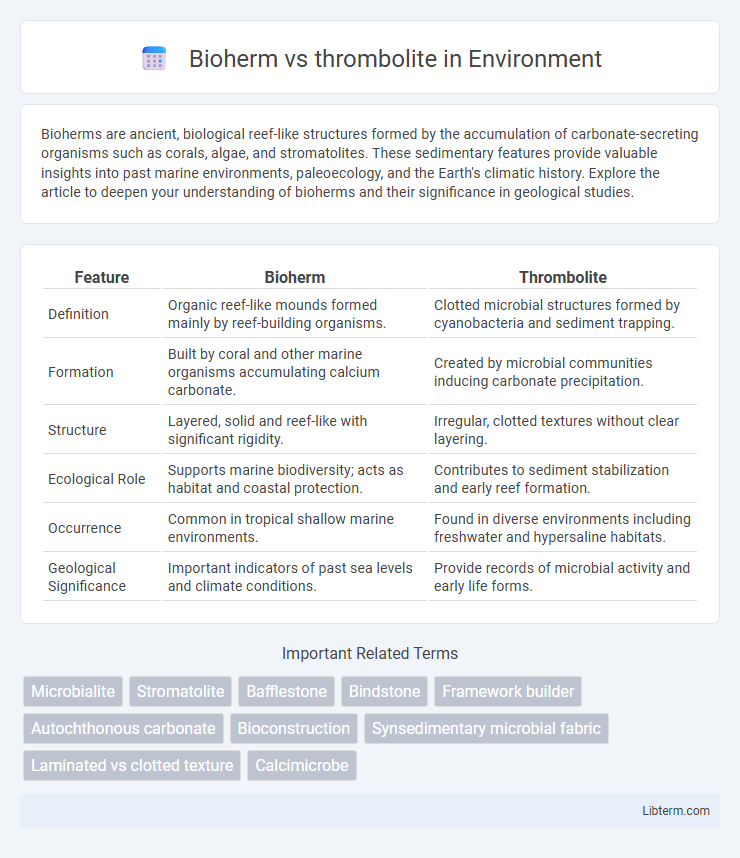Bioherms are ancient, biological reef-like structures formed by the accumulation of carbonate-secreting organisms such as corals, algae, and stromatolites. These sedimentary features provide valuable insights into past marine environments, paleoecology, and the Earth's climatic history. Explore the article to deepen your understanding of bioherms and their significance in geological studies.
Table of Comparison
| Feature | Bioherm | Thrombolite |
|---|---|---|
| Definition | Organic reef-like mounds formed mainly by reef-building organisms. | Clotted microbial structures formed by cyanobacteria and sediment trapping. |
| Formation | Built by coral and other marine organisms accumulating calcium carbonate. | Created by microbial communities inducing carbonate precipitation. |
| Structure | Layered, solid and reef-like with significant rigidity. | Irregular, clotted textures without clear layering. |
| Ecological Role | Supports marine biodiversity; acts as habitat and coastal protection. | Contributes to sediment stabilization and early reef formation. |
| Occurrence | Common in tropical shallow marine environments. | Found in diverse environments including freshwater and hypersaline habitats. |
| Geological Significance | Important indicators of past sea levels and climate conditions. | Provide records of microbial activity and early life forms. |
Introduction to Bioherms and Thrombolites
Bioherms are mound-shaped sedimentary structures built by the growth of marine organisms such as corals, sponges, or algae, playing a crucial role in reef formation and carbonate sedimentation. Thrombolites are clotted microbial structures formed by the trapping, binding, and mineral precipitation activities of cyanobacteria, distinguished by their clotted, non-laminated texture. Both bioherms and thrombolites represent significant biological contributions to carbonate buildups, but bioherms typically involve larger metazoan organisms while thrombolites are primarily microbial in origin.
Defining Bioherms: Key Characteristics
Bioherms are organosedimentary structures formed primarily by the growth of sessile benthic organisms such as corals, sponges, and algae, creating mounded or reef-like buildups in marine environments. Key characteristics of bioherms include their distinct three-dimensional morphology, complex internal framework, and significant role in carbonate sediment production. Unlike thrombolites, which exhibit clotted microbial textures without organized skeletal frameworks, bioherms rely on metazoan skeletal accumulation for structural complexity.
Understanding Thrombolites: Key Features
Thrombolites are microbial carbonate structures characterized by their clotted, non-laminar fabric formed by the trapping, binding, and mineral precipitation activities of microorganisms, primarily cyanobacteria. Unlike bioherms, which are mound-shaped reef bodies created by the accumulation of skeletal organisms, thrombolites exhibit a more chaotic, clotted texture due to irregular microbial growth patterns. Key features of thrombolites include their distinctive internal clotted microstructure, microbial mediation in calcium carbonate precipitation, and significant contributions to ancient carbonate sedimentary environments.
Geological Formation Processes
Bioherms form through the accumulation of skeletal remains and biological debris, primarily from corals, algae, and other marine organisms, leading to mound-shaped carbonate buildups. Thrombolites develop via microbial activity, especially cyanobacteria, which trap and bind sediments, resulting in clotted, non-laminated carbonate structures. Both formations reflect distinct biogenic sedimentation processes crucial to understanding ancient marine environments and carbonate platform evolution.
Differences in Microbial Composition
Bioherms predominantly consist of layered carbonate structures formed by the activity of cyanobacteria and other photosynthetic microbes, whereas thrombolites feature clotted, non-laminated textures primarily resulting from complex microbial consortia including heterotrophic bacteria. The microbial composition in bioherms is often dominated by filamentous cyanobacteria that facilitate carbonate precipitation, contrasting with thrombolites where diverse microbial populations, such as sulfate-reducing bacteria and archaea, play significant roles in mineral trapping and binding. These differences in microbial assemblages directly influence the resulting morphology and sedimentary fabric, making bioherms more laminated and thrombolites more clotted and irregular.
Morphological Comparisons
Bioherms exhibit complex, mound-shaped buildups primarily composed of microbial mats and skeletal remains, forming distinct topographic highs in sedimentary environments. Thrombolites possess a clotted, irregular internal texture lacking the laminated structures typical of stromatolites, characterized by randomly arranged microbial aggregations. Morphologically, bioherms display more organized and larger-scale buildups, whereas thrombolites show less stratification with a distinctive meshlike, clotted fabric.
Environmental Settings and Distribution
Bioherms primarily form in warm, shallow marine environments with moderate to high energy levels, often associated with carbonate platforms and reefs. Thrombolites commonly develop in hypersaline, low-energy settings such as lagoons and restricted marine environments, where microbial activity dominates sediment stabilization. Bioherms exhibit a widespread distribution in Phanerozoic strata, whereas thrombolites are predominantly confined to Precambrian and select modern analog habitats.
Paleoenvironmental Significance
Bioherms are reef-like mounds formed by the accumulation of skeletal remains and microbial activity, indicating high-energy, nutrient-rich shallow marine environments during the Paleozoic era. Thrombolites, characterized by clotted microbial textures, typically develop in calmer, often hypersaline or low-energy settings, reflecting specialized microbial communities and specific chemical conditions. The study of these structures reveals crucial information about ancient water chemistry, sea level fluctuations, and microbial ecosystem dynamics in Paleoenvironmental reconstructions.
Economic and Scientific Importance
Bioherms, as ancient carbonate buildups formed by the activity of marine organisms, serve as significant reservoirs for hydrocarbons, making them crucial in the petroleum industry and economic exploration. Thrombolites, characterized by their clotted microbial structures, are valuable to scientific research for understanding early microbial life and sedimentary processes, offering insights into Earth's biological and geological history. Both hold economic importance in fossil fuel exploration and scientific relevance in paleobiology and sedimentology, bridging economic interests with advancements in earth sciences.
Summary: Bioherm vs Thrombolite
Bioherms are mound-shaped reef-like structures formed predominantly by the growth and accumulation of calcareous organisms such as corals and algae, creating rigid frameworks with diverse fossil content. Thrombolites are microbially induced carbonate buildups with a clotted, non-laminated texture, primarily produced by cyanobacterial activity trapping and binding sediment grains. Both structures serve as important paleoenvironmental indicators, but bioherms typically represent more complex, biotic reef ecosystems whereas thrombolites reflect microbial mat-dominated depositional settings.
Bioherm Infographic

 libterm.com
libterm.com